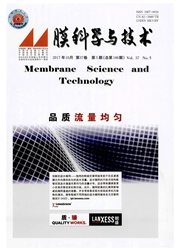

 中文摘要:
中文摘要:
以商业化的Kapton型聚酰胺酸为前驱体制备了低温热解炭膜,采用热重质谱(TG—MS)、红外光谱(FTIR)、元素分析(EA)、X射线衍射(XRD)和气体渗透等手段对不同温度、不同气体氛围下制备出的膜的化学结构、微结构和气体分离性能变化规律进行了研究.结果表明,低温热解温度和气体氛围对炭膜的化学结构、微结构存在着显著的影响,进而影响到炭膜的气体分离性能,表现为450℃之前气体渗透系数变化很小,450℃以后气体渗透系数逐渐增大,分离系数逐渐下降,同时空气促进了热分解和热交联反应的进行,炭膜具有较大的气体渗透系数和较小的气体分离系数.
 英文摘要:
英文摘要:
Low temperature pyrolytic membranes were prepared from Kapton-Type Polyimide. TG-MS, FTIR, EA, XRD and gas permeability were used to character the change of chemical structure and microstructure, the gas separation performance during the low temperature pyrolysis at different temperatures and atmosphere. Results show that pyrolytic temperature and atmosphere have a great impact on chemical and carbon structure and the gas separation performance of low temperature carbon membrane. There is no evident variation of gas permeability before 450 ℃ and the gradual enlargement in gas permeability and decrease in gas selectivity with the increase of temperature after 450 ℃. The carbon membranes prepared in air have a larger gas permeability and lower selectivity than those prepared in nitrogen.
 同期刊论文项目
同期刊论文项目
 同项目期刊论文
同项目期刊论文
 Comparison study of the effect of PVP and PANI nanofibers additives on membrane formation mechanism,
Comparison study of the effect of PVP and PANI nanofibers additives on membrane formation mechanism, Visualization of the Formation of Interfacially Polymerized Film by an Optical Contact Angle Measuri
Visualization of the Formation of Interfacially Polymerized Film by an Optical Contact Angle Measuri Novel tertiary amino containing thin film composite membranes prepared by interfacial polymerization
Novel tertiary amino containing thin film composite membranes prepared by interfacial polymerization Performance Improvement of Polysulfone Ultrafiltration Membrane Using Well-Dispersed Polyaniline-Pol
Performance Improvement of Polysulfone Ultrafiltration Membrane Using Well-Dispersed Polyaniline-Pol An Effective Method to Improve the Performance of Fixed Carrier Membrane via Incorporation of CO2-se
An Effective Method to Improve the Performance of Fixed Carrier Membrane via Incorporation of CO2-se Gas separation performance of C/CMS membranes derived from poly(furfuryl alcohol) (PFA) with differe
Gas separation performance of C/CMS membranes derived from poly(furfuryl alcohol) (PFA) with differe Preparation of dual-layer cellulose/polysulfone hollow fiber membrane and its performance for isopro
Preparation of dual-layer cellulose/polysulfone hollow fiber membrane and its performance for isopro An antioxidative composite membrane with the carboxylate group as a fixed carrier for CO2 separation
An antioxidative composite membrane with the carboxylate group as a fixed carrier for CO2 separation High performance antioxidative and acid resistant membrane prepared by interfacial polymerization fo
High performance antioxidative and acid resistant membrane prepared by interfacial polymerization fo Improvement of CO2/N-2 separation characteristics of polyvinylamine by modifying with ethylenediamin
Improvement of CO2/N-2 separation characteristics of polyvinylamine by modifying with ethylenediamin Performance improvement of polysulfone ultrafiltration membrane using PANiEB as both pore forming ag
Performance improvement of polysulfone ultrafiltration membrane using PANiEB as both pore forming ag High-performance membranes comprising polyaniline nanoparticles incorporated into polyvinylamine mat
High-performance membranes comprising polyaniline nanoparticles incorporated into polyvinylamine mat Formation-structure-performance correlation of thin film composite membranes prepared by interfacial
Formation-structure-performance correlation of thin film composite membranes prepared by interfacial Effects of Curing Method on the Gas Separation Performance of Phenolic Resin/Poly(vinyl Alcohol)-Bas
Effects of Curing Method on the Gas Separation Performance of Phenolic Resin/Poly(vinyl Alcohol)-Bas Gas separation performance of C/CMS membranes derived from poly (furfuryl alcohol) (PFA) with differ
Gas separation performance of C/CMS membranes derived from poly (furfuryl alcohol) (PFA) with differ Effects of precursor preoxidization on the structure and gas separation properties of polyetherimide
Effects of precursor preoxidization on the structure and gas separation properties of polyetherimide Preparation of C/CMS composite membranes derived from Poly(furfuryl alcohol) polymerized by iodine c
Preparation of C/CMS composite membranes derived from Poly(furfuryl alcohol) polymerized by iodine c Controlled synthesis of high performance carbon/zeolite T composite membrane materials for gas separ
Controlled synthesis of high performance carbon/zeolite T composite membrane materials for gas separ 期刊信息
期刊信息
